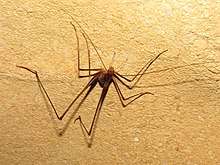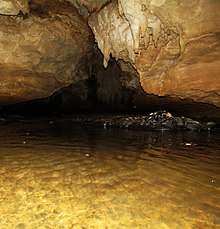Pachyrhamma waitomoensis
Pachyrhamma waitomoensis, known as the Waitomo cave weta, is a large species of cave weta (New Zealand cave cricket, tokoriro),[1] native to the Waitomo district of New Zealand.[2]
| Pachyrhamma waitomoensis | |
|---|---|
 | |
| An adult male P. waitomoensis on a cave wall in Mangahopue cave, Waitomo | |
| Scientific classification | |
| Kingdom: | Animalia |
| Phylum: | Arthropoda |
| Class: | Insecta |
| Order: | Orthoptera |
| Suborder: | Ensifera |
| Family: | Rhaphidophoridae |
| Genus: | Pachyrhamma |
| Species: | P. waitomoensis |
| Binomial name | |
| Pachyrhamma waitomoensis Richards, 1958 | |
Cook et al (2010) follow W.F. Kirby (1906) and Karny (1937) in treating Pachyrhamma as a neuter noun, and thus use a neuter suffix for the species name, i.e. waitomoense rather than waitomoensis.[3]
Ecology and natural history
P. waitomoensis form aggregations near the entrances of caves during daytime, often in crevices or among stalactites.[4] The juveniles are quite inactive during daylight, generally remaining still unless disturbed. Adults form pairs which mate repeatedly throughout the day, often breaking up and reforming in different combinations. Females leave the aggregations to lay their eggs, which they do by piercing their ovipositor into soft clay on ledges and in crevices within the cave. After being laid the eggs take about eight months to hatch.[4]

At dusk the weta emerge from the cave, seeming more likely to do so when conditions outside are darker (less moonlight) and wetter.[4] Outside of caves the weta scavenge on and amongst plants, searching for plant, animal and fungal material to eat.[4]
The complete life cycle from hatching to death takes approximately two years.[4] Adults are present year-round, but most abundant from late summer to early winter. Many caves inhabited by P. waitomoensis are solutional limestone karst, with active waterways flowing through them. The weta are adept at navigating within this environment and can even tread across the surface of water without sinking.
References
- Richards, Aola (1959). "Revision of the Rhaphidophoridae (Orthoptera) of New Zealand Part VI" (PDF). Transactions of the Royal Society of New Zealand. 87: 329–332 – via Royal Society of New Zealand.
- Richards, Aola (1958). "Revision of the rhaphidophoridae (Orthoptera) of New Zealand. Part III - The genera pachyrhamma Brunner and pallidoplectron n.g." (PDF). Transactions of the Royal Society of New Zealand. 85: 695–706.
- Cook, Lorraine D.; Trewick, Steven A.; Morgan-Richards, Mary; Johns, Peter M. (2010). "Status of the New Zealand cave weta (Rhaphidophoridae) genera Pachyrhamma, Gymnoplectron and Turbottoplectron". Invertebrate Systematics. 24 (2): 131. doi:10.1071/IS09047. ISSN 1445-5226.
- Richards, Aola M. (1961). "Some observations on New Zealand cave-wetas". Tuatara. 9 (2): 80–83. Retrieved 9 September 2017.